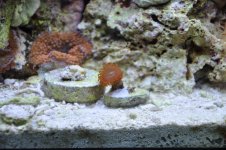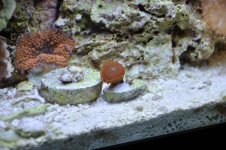You are using an out of date browser. It may not display this or other websites correctly.
You should upgrade or use an alternative browser.
You should upgrade or use an alternative browser.
ID Polyp Please
- Thread starter marki24
- Start date
Pedro Nuno Ferreira
Liquid Breathing
- Location
- Portugal - Vila Nova de Gaia
- Location
- poughquag, ny
looks like a un colored up rpe or not, wait a few weeks see if it changes color
Nah i doubt it cause at the members house it was the same color.
All that proves is that neither of you have the ideal lighting for that specific coral. It's an RPE.
And what would an ideal lighting be and also what does that have to do with it being in my tank for a day? Is it suppose to change color in 24 hours???:splitspinAll that proves is that neither of you have the ideal lighting for that specific coral. It's an RPE.
Pedro Nuno Ferreira
Liquid Breathing
- Location
- Portugal - Vila Nova de Gaia
And what would an ideal lighting be and also what does that have to do with it being in my tank for a day? Is it suppose to change color in 24 hours???:splitspin
it has a lot to do! Please read this
Animals from intensely lit areas of a reef that are not supplied with similar lighting in captivity may appear to change color as they shed unnecessary U.V. reflective pigments. At that point, such animals may appear to be darkening in color, often to a darker brown or golden color. The aquarist often associates this with a decline in health, although that is not necessarily the case. The color change may be attributable to an increase in the population of zooxanthellae algae, or simply the greater visibility of resident zooxanthellae now visible in the absence of the U.V. reflective pigments. Whether the change is intolerable or not depends on if the coral?s fundamental needs are being met by the decreased illumination. Many corals can survive in captivity with less surface irradiance than the optimum levels received in the wild environment so long as the compensation point of photosynthesis is met. We call this photoadaptation. And even without it, supplemental feeding of the animal can be compensatory.
http://www.wetwebmedia.com/acclimcoralslight.htmand this and this
The intensity of captive light is also an important issue. Due to space limitations I can only briefly cover the subject here. Most corals imported for the captive market come from shallow water locations. This does not mean that all corals imported are bright light corals. Some of these corals will come from shaded shallow water areas and they will be low light corals. However, the majority of imported corals will be strong light corals that expect from 700 to 1,200 micro Einsteins/square meter per second. Within the stony coral book I am writing for TFH/Microcosms I have constructed guidelines for establishing different light intensities. What I have basically done is define light intensities into 4 differentlevels that are: weak light; moderate light; strong light; and intense light. As a basic guideline, strong light is typically achieved with the use of 400 watt halides. Intense light is typically achieved with the use of 1,000 watt halides. Weak and moderate light levels can be achieved with 175 to 250 watt metal halides and power compact fluorescents. There are actually quite a few low to moderate light corals being farmed within captive systems. For example, I have been farming and distributing an Echinopora lamellosa that actually prefers weak to moderate light. It develops a very nice blue fluorescing pigment in weak to moderate light, but will loose the pigment in strong light.
and there is more so if you wish to further search, please perform a :google:search by "lighting and pigmentation of corals" or "light and pigmentation of corals"
Cheers
Pedro Nuno;-)







